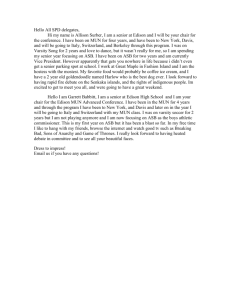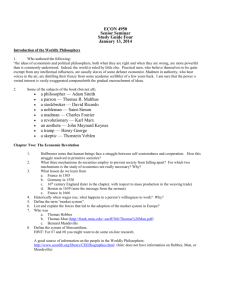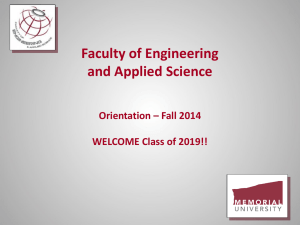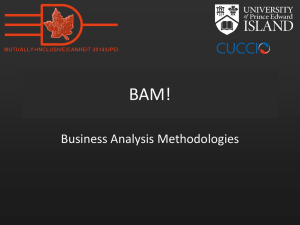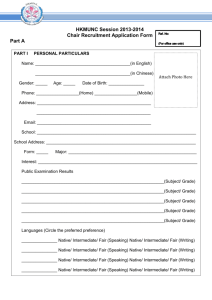COURSE 7944 ROBOTICS AND AUTOMATION
advertisement
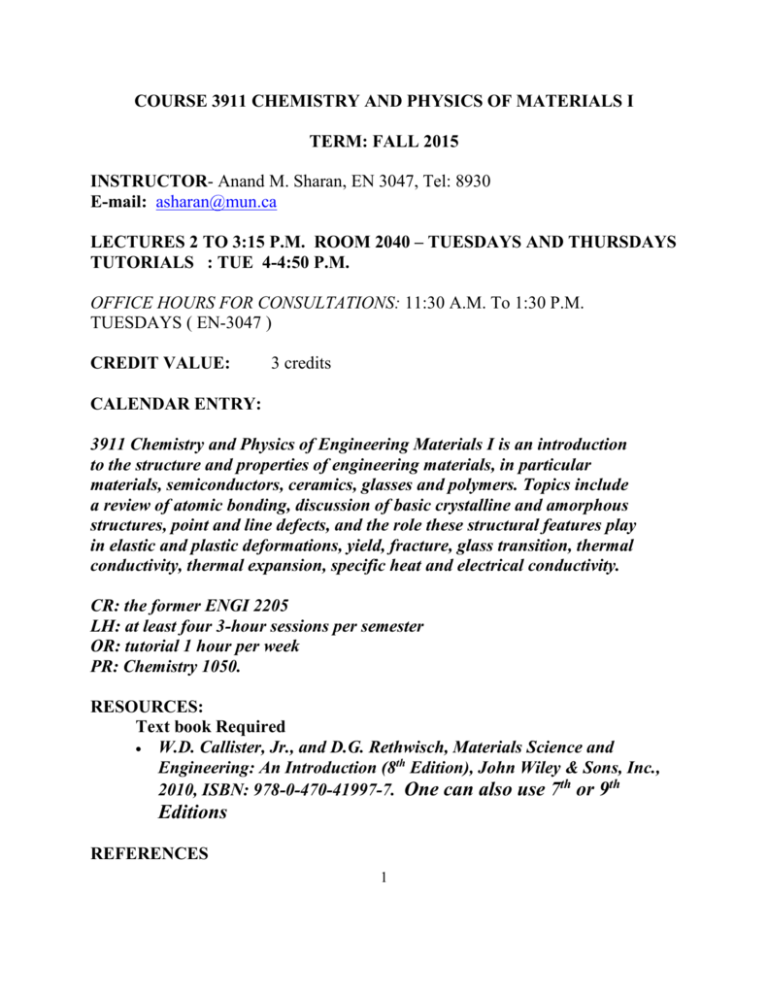
COURSE 3911 CHEMISTRY AND PHYSICS OF MATERIALS I TERM: FALL 2015 INSTRUCTOR- Anand M. Sharan, EN 3047, Tel: 8930 E-mail: asharan@mun.ca LECTURES 2 TO 3:15 P.M. ROOM 2040 – TUESDAYS AND THURSDAYS TUTORIALS : TUE 4-4:50 P.M. OFFICE HOURS FOR CONSULTATIONS: 11:30 A.M. To 1:30 P.M. TUESDAYS ( EN-3047 ) CREDIT VALUE: 3 credits CALENDAR ENTRY: 3911 Chemistry and Physics of Engineering Materials I is an introduction to the structure and properties of engineering materials, in particular materials, semiconductors, ceramics, glasses and polymers. Topics include a review of atomic bonding, discussion of basic crystalline and amorphous structures, point and line defects, and the role these structural features play in elastic and plastic deformations, yield, fracture, glass transition, thermal conductivity, thermal expansion, specific heat and electrical conductivity. CR: the former ENGI 2205 LH: at least four 3-hour sessions per semester OR: tutorial 1 hour per week PR: Chemistry 1050. RESOURCES: Text book Required W.D. Callister, Jr., and D.G. Rethwisch, Materials Science and Engineering: An Introduction (8th Edition), John Wiley & Sons, Inc., 2010, ISBN: 978-0-470-41997-7. One can also use 7th or 9th Editions REFERENCES 1 Students are encouraged to make use of QEII library, the world-wideweb (www), and internet resources in addition to the textbook to help learn concepts and write reports. COURSE CONTENTS CHAPTERS 1 to 4 ; 6, 7 ; 12.1 to 12. 5; 14. 1 to 14.12; 18.1 to 18.12 ; 19 ( a ) REFER TO THE WEB http://www.engr.mun.ca/~asharan/courses/3911_LECTURES/ FOR LECTURE NOTES (TRANSPARENCIES) (b) ALWAYS CHECK THE FILE CALLED NOTICE_BOARD_2015.doc IN THIS WEB DIRECTORY FOR INSTRUCTOR’S MESSAGES TO THE STUDENTS. MAJOR TOPICS: Ch1: Introduction to Materials Science & Engineering Ch2: Atomic Structure & Interatomic Bonding Ch3: The Structure of Crystalline Solids Ch4: Imperfections in Solids Ch6: Mechanical Properties Ch7: Deformation & Strengthening Mechanisms Ch12: Structures & Properties of Ceramics Ch14: Polymer Structures Ch18: Electrical Properties Ch19: Thermal Properties Laboratories REFER TO: http://www.engr.mun.ca/~asharan/courses/3911_LABS/ FOR MORE INFORMATION REGARDING LAB MANUALS 2 Laboratory 1: ( a ) VERNIERS AND UNCERTAINITIES, ( b ) APPLICATIONS OF SEMICONDUCTORS IN THE FIELD OF ALTERNATE ENERGY Laboratory 2: ELASTIC PROPERTIES OF RUBBER Laboratory 3: ELECTRICAL RESISTANCE AND RESISTIVITY Laboratory 4: THERMAL CONDUCTIVITY Learning Outcomes for ENGI 3911 Chemistry and Physics of Engineered Materials I After completion of this course, the student should be able to perform the following skills successfully: 1. Crystallography and Crystal Structures a. Identify, draw, and describe the structures of crystalline solids (simple cubic, BCC, FCC, HCP) b. Define what crystal systems are and determine crystallographic directions and planes 2. Mechanical Properties of Materials a. Define imperfections in solids and their effect on mechanical properties of materials (impurities, dislocations, grain boundaries) b. Define and describe stress-strain behavior of metals, polymers, and ceramics c. Define the mechanical properties of strength, ductility, hardness, elasticity, stiffness, plasticity and identify them on a stress-strain curve d. Be familiar with experimental testing of tensile-compressive-loading hardness testing methods (Rockwell, Brinell, Vickers) 3. Phase Diagrams a. Define and describe the features of a binary phase diagram (phases, compositions, mass fractions, microstructures) 4. Microstructural and Mechanical Properties of Ceramic Structures a. Describe the different crystal structures of ceramics b. Describe the characteristic mechanical properties of ceramics 5. Microstructural and Mechanical Properties of Polymer Structures a. Describe the different types of polymers (thermoplastics, thermosets) b. Describe the characteristic mechanical properties of polymers 3 In relation to the Engineering profession, the learning outcomes for the course are for the students to: Understand and elaborate upon the role and relevance of materials science in Mechanical Engineering, Electrical Engineering, Civil Engineering, Ocean/Naval Engineering, and Process Engineering Show that they are knowledgeable about the fundamental classes of materials and their structure and properties Engage in introductory discussions about the processing, applications and performance of the fundamental classes of materials involved in materials selection and design problems Use experimental techniques and computational skills, along with critical thinking, to address and analyze material property questions See the role of materials science in a well-rounded Engineering education, preparing them to contribute effectively as individual professional and as team members in academia, industry and government Engage in integrating materials engineering concepts with societal issues of economics, innovation, technology, ethics, quality of life and human values; Communicate effectively – orally and in writing– the concepts and results of materials science and engineering investigations to both technical and nontechnical audiences Recognize that the field of materials has a deep history and is continually evolving as new knowledge and materials are developed, requiring consistent consideration (“lifelong scholarship”) Develop an awareness of modern materials engineering practice and interest in current issues in the application of materials 4 MARKS BREAKDOWN BETTER OF THE TWO OPTIONS ASSIGNMENT LAB TEST ( OCT 22, 2015 ) TENTATIVE FINAL TOTAL Assignments 5% Assignment 1(Ch2) Assignment 2(Ch3) Assignment 3(Ch4) Assignment 4(Ch6) Assignment 5(Ch7) Labs (4 total) OPTION 1 5 15 25 OPTION 2 5 15 30 55 100 50 100 (1% each) Sept 24 Oct 1 Oct 8 Oct 29 Nov 5 15% Due at the end of each Laboratory Assignments are submitted individually ( a ) in class or ( b ) in the General Office by 4 P.M. on the due date. Late assignments will not be marked unless the student provides a medical doctors note (sickness). All labs are required to be performed and the students are required to read the lab manual before coming to the lab. If a student does not participate in a lab then he or she will receive an incomplete in the course. Lab reports have to be written in the lab itself and handed in at the end before leaving the lab. The students have to bring and submit labs in a lab notebook (one per group). Calculators for midterm and final exam should be a simple non-programmable. If notes or formulas can be stored on the calculator then they should be deleted prior to the midterm or final exam, since this constitutes an Academic Offence “using unauthorized aids” page 77 of the MUN 2012-2013 Calendar. PLEASE NOTE: ( 1 ) TEST AND FINAL – CLOSED BOOK ; NO FORMULA SHEETS ALLOWED. PROBLEMS TO BE SOLVED USING FORMULAS GIVEN IN THE TEST OR FINAL 5 SIMPLE CALCULATOR IS ALLOWED. ( 2 ) TEST AND FINAL TOGETHER = 80 MARKS , WHICH WILL HAVE THEORY QUESTIONS = 65 MARKS MORE OR LESS, AND NUMERICAL PROBLEMS = 15 MARKS APPROXIMATELY. (3) NUMERICAL PROBLEMS WILL BE SIMILAR TO ASSIGNMENTS QUESTIONS OR WORKED OUT PROBLEMS IN THE BOOK OR IN THE CLASS. ( 4 ) THE TEST OR FINAL –HAS TO BE WRITTEN IN INK WITH A FONT SIZE APPROXIMATELY EQUAL TO 12 OR GREATER ( 5 ) ANY SKETCHES DRAWN HAVE TO BE CLEAR AND CLEAN. LABS ( 6 ) LAB INSTRUCTIONS CAN BE DOWNLOADED FROM MY WEB http://www.engr.mun.ca/~asharan/courses/3911_LABS/ FOR LAB 1, PLEASE DOWNLOAD THE FOLLOWING FILES FROM THE ABOVE WEBSITE : LabManual2009.doc 05-Sep-2009 15:35 40K INSTRUCTIONS_LAB1.pdf 03-Sep-2009 14:08 691K CALIP_MICRO_UNCERT_V1.pdf 09-Sep-2009 14:25 568K USE_OF_SEMICONDUCTING_MATERIALS.docx ( 7 ) LAB TEACHING ASSISTANTS WILL SHOW - HOW TO DO THE LABS, AND WILL HELP YOU IN WRITING YOUR REPORTS. REPORTS CAN BE WRITTEN USING FIGURES IN THE INSTRUCTION MANUAL. YOU CAN BRING YOUR OWN DIGITAL CAMERA AND 6 TAKE PHOTO OF THE APPARATUS WHICH CAN REPLACE SKETCHING WHILE EXPLAINING IN YOUR REPORT. ( 8 ) NAME OF EACH STUDENT HAS TO BE WRITTEN IN THE REPORT. LAB INSTRUCTORS WILL RECORD THE NAME OF ANY STUDENT WHO WILL BE ABSENT ( 9 ) AGAIN, ALL THE LABS ARE REQUIRED TO BE PERFORMED TO COMLETE THE COURSE. (14) TO DOWNLOAD THE LECTURE TRANSPARENCIES – STUDENTS HAVE TO PURCHASE 7th, or 8th, or 9th EDITION OF THE TEXTBOOK. ACADEMIC INTEGRITY AND PROFESSIONAL CONDUCT: Students are expected to conduct themselves in all aspects of the course at the highest level of academic integrity. Any student found to commit academic misconduct will be dealt with according to the Faculty and University practices. More information is available at www.engr.mun.ca/undergrad/academicintegrity. Students are encouraged to consult the Faculty of Engineering and Applied Science Student Code of Conduct at http://www.engr.mun.ca/policies/codeofconduct.php and Memorial University’s Code of Student Conduct at http://www.mun.ca/student/home/conduct.php. LAB SAFETY: Students are expected to demonstrate awareness of, and personal accountability for, safe laboratory conduct. Appropriate personal protective equipment (PPE) must be worn (e.g. steel-toed shoes, safety glasses, etc.) and safe work practices must be followed as indicated for individual laboratories, materials and equipment. Students will immediately report any concerns regarding safety to the teaching assistant, staff technologist, and professor. CSA approved safety shoes and safety glasses are required in designated 7 laboratories as per the current safety policy (see Laboratory supervisor: Mr Haibing Wang, Office EN-1020). INCLUSION AND EQUITY: Students who require physical or academic accommodations are encouraged to speak privately to the instructor so that appropriate arrangements can be made to ensure your full participation in the course. All conversations will remain confidential. The university experience is enriched by the diversity of viewpoints, values, and backgrounds that each class participant possesses. In order for this course to encourage as much insightful and comprehensive discussion among class participants as possible, there is an expectation that dialogue will be collegial and respectful across disciplinary, cultural, and personal boundaries. STUDENT ASSISTANCE: Student Affairs and Services offers help and support in a variety of areas, both academic and personal. More information can be found at www.mun.ca/student. ADDITIONAL INFORMATION: In general, students who behave professionally, attend class, perform all of the components of the course, manage their time on task efficiently, and study for the major components (midterm, final exams) ahead of schedule tend to perform better than those who do not. 8
